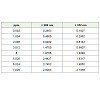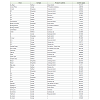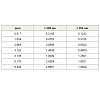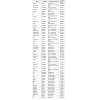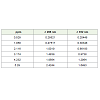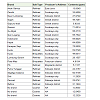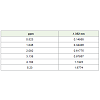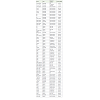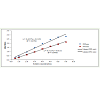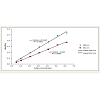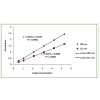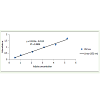Research Article
Iodized Salt Profile at Regional Markets in East Java According to the Indonesian National Standard Analyzed by Spectrophotometric Method
Armunanto MPH1*, Djoko Agus Purwanto2, Achmad Toto Poernomo2
1School of Public Health, Health Policy Studies, Airlangga University, Surabaya, Indonesia; currently affiliated with UNICEF Indonesia, Surabaya, Indonesia
2Faculty of Pharmacy, Department of Pharmaceutical Chemistry, Airlangga University, Surabaya, Indonesia
Corresponding author: Armunanto MPH, School of Public Health, Health Policy Studies, Airlangga University, Surabaya,Indonesia, Mulyorejo Street Campus C, Airlangga University Surabaya 60115, Tel: +62 811274845; Fax: +62 31 5965308; E-mail: armunanto_armunanto@yahoo.com
Citation: Armunanto MPH, Purwanto DA, Poernomo AT. Iodized Salt Profile at Regional Markets in East Java According to the Indonesian National Standard Analyzed by Spectrophotometric Method. Indian J Nutri. 2016;3(1): 129.
Copyright © 2016 Armunanto MPH, et al. This is an open access article distributed under the Creative Commons Attribution License, which permits unrestricted use, distribution, and reproduction in any medium, provided the original work is properly cited.
Indian Journal of Nutrition | ISSN: 2395-2326 | Volume: 3, Issue: 1
Submission: 17/06/2016; Accepted: 01/07/2016; Published: 07/07/2016
Abstract
Background and Objectives: A study on the iodine contents of iodized salt at regional markets in Blitar, Ngawi, Gresik, and Pasuruan districts, East JavaProvince has been held by analysing 202 samples of various brands from 21 regional markets. Insufficiency of iodine intake could lead to symptoms of iodinedeficiency and disturbances such as mumps, extreme fatigue, mental retardation, and depression that collectively called IDDs. Therefore, the measurementof iodate in salt sample is important to know the difference of iodine contents in some salt samples that might be influenced by certain conditions, such asenvironments, transportation, package, and cooking methods.
Methods: The measurement of iodine-contents was done using the spectrophotometric method on λ 288 nm to λ 352 nm wavelength.
Results: The research revealed that in Blitar district, 20% iodized salt meet the Indonesian National Standard (SNI), while 80% did not meet the standard. In Ngawi district, 54% met the standard and 46% did not. In Gresik district, 50% meet the standard and 50% did not. In Pasuruan district, 50% met and 50%did not meet the standard.
Conclusions: There is still circulating salt that does not meet the requirements of SNI (a minimum of iodine-containing 30 ppm) and even some salt in circulation are still contain no iodine.
Keywords: Iodine-contents; Indonesian National Standard (SNI); Iodine; Spectrophotometric; East Java; Province.
Introduction
Iodine is a trace element compound which is important forhuman’s nutrition. The World Health Organization (WHO)recommends 100mg/day for infants and 150mg/day for adult’s intakeof iodine [1]. Iodine is essential for synthesizing T3 and T4 hormonesby thyroid glands [2]. The deposit of iodine in human body is the thyroid gland. Insufficiency of iodine intake could lead to symptomsof iodine deficiency and disturbances such as mumps, extremefatigue, mental retardation, and depression that collectively calledIDDs.
In 2015, WHO data shows there were 130 countries with IDDsproblems, 48% in Africa, 41% in South East Asia and 11% in Europe and West Pacific. In Indonesia, between 1982 and 1990, the IDDsprevalence decreased from 37.2% to 27.7%, and in 1998 became 9.8%,while in 2003 the IDDs prevalence slightly increased to 11.1% [3].It could be seen from the number of hyperthyroid and hypothyroidpatients that were found almost in all regions in Indonesia. There arenatural sources of iodine that can be found in food, including milk,vegetables, fruits, cereals, eggs, meat, spinach, and seafoods [4]. Yet,these natural sources of iodine might not fulfill the standard requiredby human bodies, because of the contents are too small [5-7].
The sufficient iodine intake could be done by consuming iodizedsalt. Iodized salt are made by adding iodate to salt sample, since it hasgood stability and bioavailability [8]. Therefore, the measurement ofiodate in salt sample is important to know the difference of iodinecontents in some salt samples that might be influenced by certainconditions, such as environments, transportation, package, andcooking methods [9].
Pasting properties of food can be correlated to the cooking qualityand textural of the food hence a good index of textural quality in moststarchy foods. The pasting temperature gives an indication of theminimum temperature to cook a food.
It is known that the salt distributed in East Java Province, bothfor common consumption and for food industries’ supply, shouldmeet the Indonesian National Standard (SNI); There is also a LocalRegulation issued by the East Java government number 11 in 2011about community nutrition, since there were still many nutritionaldeficiency disease and also micro and macro nutrition insufficiencywhich cause stunted growth in East Java Province. In the localregulation, article 21 a, stated that the Counter measurement ofIDDs was done by strengthening various fortification efforts. Theproblem is wether or not the fortification of Potassium Iodate in saltproduction done homogenously by farmers in order to meet the SNIin 2010 with minimum contents more than 30ppm.
Therefore, this research would examine the iodine content iniodized salt that are distributed at four regional markets in Blitar,Ngawi, Gresik and Pasuruan district. Blitar and Ngawi districts werechosen to represent area with no salt producer, while Gresik andPasuruan represented the areas with many salt producers. The studywas done by using UV-V is spectrophotometric method with 288nmand 352nm wavelength.
Methods
The method of spectrophotometric measuring equipment used inthis study was the Spectrophotometer HP 8452A. Other equipmentwere funnels, measuring cups, volumetric flasks, and other glassequipment.
The materials used were analytical grade materials and dissolved inaquadest. The materials were Potassium iodide (E. Merck), potassiumiodate (E. Merck), various brands of salt, and sodium chloride (E.Merck). NaOH, HCl. The solution was dissolved in demineralizedaquadest in Erlenmeyer flask. The calibration curves was processedby using Microsoft Excel (Tables 1-8).
Results
Blitar District
The total population of Blitar District is 1,268,194 persons(637,419 females and 630,775 males). Area of that district is about1,588 km² the population density is 700 persons/km¹. The districtconsists of 22 sub-districts and 248 villages. Location of that district is from 111°40¹ till 112°10¹ east longitude and 7°58¹ till 8°9¹51¹ southlatitude. Labor force sectors are agricultural (60%), service (25%), andmanufacture (15%).
This is the profile of iodized salt in Blitar district markets, byMarch - August 2015. According to the SNI (Indonesian NationalStandard) requirement, majority (80%) of salt consumption do notmeet the standard whilst the rest (20%) meet the standard. Both ofsalts are sold in 62 traditional markets in Blitar. Types of those SNIsalts are briquettes (11%), coarse (33%), and refined (56%). As thereagent, 3.32gr KI was dissolved in aquadest until 100mL (KI 3.32%),add 5gr NaCl that has been dissolved in aquadest until 50mL (NaCl10%), and 85% phosphoric acid made by dissolving 11.5gr phosphoricacid in aquadest until 100mL.
The Potassium Iodate (KIO3) standard solution was made bydissolving 0,1000gr KIO3 in 100mL volumetric flask, added with aquadest until exactly to the 1000ppm mark. Put 10mL KIO3 standardsolution 1000ppm into 100mL volumetric flask, and add aquadest tothe 100mL mark (100ppm).
The Potassium Iodate (KIO3) standard solution was made bydissolving 0,1000gr KIO3 in 100mL volumetric flask, added withaquadest until exactly to the 1000ppm mark. Put 10mL KIO3 standardsolution 1000ppm into 100mL volumetric flask, and add aquadest tothe 100mL mark (100ppm).
Calibration curve was made by dissolving 0.05mL to 0.6mL KIO3100ppm standard solution + 1mL 3.32% KI solution + 2mL 10% NaClsolution + 1mL phosphoric acid + added with aquadest to 10mL.Form: 1mL 3.32% KI solution + 1mL phosphoric acid + aquadestuntil 10mL. Examined by spectrophotometer in 288 nm and 352 nmwavelength. Regression: y = bx + a (y = absorbent; x = concentration).
Sample preparation; 0.2000gr salt sample dissolved with someaquadest (ultrasonic) + 1mL 3.32% KI solution + 1mL phosphoric acid+ added with aquadest to 10mL. Examined by spectrophotometricmethod in 288 nm and 352 nm wavelength.
Types of those non SNI salts in Blitar District are briquettes (20%),refined (29%), and coarse (51%). The SNI iodine salt consumption arefrom PT. Elitestar (11%), Indomaret (11%), Pasuruan (11%), Kediri(11%), Sidoarjo (11%), and Surabaya (45%).
Ngawi District
Total population of Ngawi District is 911,911 persons (463,487females and 448,424 males). Area of that district is about 1,298 km²;the population density of is 705 persons/km². In that area there are19 sub-districts and 217 villages. Location of that district is from 7°21¹ till 7°31¹ south latitude and 110°10¹ till 111°40¹ east longitude. Sectors of labor force are agricultural (90%) and service (10%).
This is the profile of iodized salt sold in 29 traditional marketsin Ngawi District, by March–August 2015. Based on the SNIrequirement, majority (54%) of salt consumption meet the standard,whilst the rest (46%) do not meet the standard. Both of salts areavailable in 29 Ngawi traditional markets. Types of those SNI salts arecoarse (21%), briquettes (32%), and refined (47%).
Types of those non SNI salts in Ngawi District are briquettes(13%), refined (37%), and coarse (50%). The SNI iodine saltconsumption are from Sampang (5%), Surabaya (21%), Sidoarjo(21%), and Pati (53%).
Gresik District
Total population of Gresik District is 1,324,777 persons (657,209females and 667,568 males). Area of that district is about 1,191 km²;the population density is 1,112 persons/km². The area consists of 18sub-districts and 356 villages. Location of that district is from 112° till 113° east longitude and 7° till 8° south latitude. Labor force sectors are agriculture (60%) and service/manufacture (40%).
This is the profile of iodized salt in 22 traditional markets in Gresik District, by March - August 2015. Based on the SNI requirement, it is found that the standardized salt is as much as the non- standardizedsalt. Types of those SNI salts are coarse (8%) and refined (92%).
Types of those non SNI salts in Gresik District are coarse (22%),refined (39%), and briquettes (39%).
The SNI iodine salt consumption are from Indomaret (8%),Gresik (17%), Sidoarjo (17%), and Surabaya (58%).
Pasuruan Distric
The total population of Pasuruan District is 1,510,261 persons(762,885 females and 747,376 males). Area of that district is 147.401Ha; the population density is 1,024 persons/km². The district consistsof 24 sub- districts and 365 villages. Location of this district is from112°55¹ till 113°37¹ east longitude and 32°31¹ till 30°20¹ southlatitude. Labor force sectors of this district are agriculture (60%) andservice/manufacture (40%). There are 30 traditional markets availablein this district (Figures 1-4).
This is the profile of iodized salt in 30 Pasuruan traditional markets, by March-August 2015. As well as in Gresik District, it isfound in Pasuruan District that the SNI standardized salt is as muchas the non-standardized salt. Types of those SNI salts are coarse(12%), briquettes (16%), and refined (72%). On the other hand, typesof the non-SNI salts are coarse (12%), refined (40%), and briquettes(48%). The SNI iodine salt consumption are from Sampang (4%),Bandung (8%), East Java (8%), not known (8%), Pasuruan (16%),without brands (16%), Surabaya (20%), and Sidoarjo (24%).
Conclusions
56% of refined salt, 33% of coarse salt and 11% of briquette saltin Blitar District were iodized salt that meet the SNI standard. 51%coarse salt, 29% refined salt, and 20% briquette salt in Blitar didnot meet the SNI standard. The origin of iodized salt that meet theSNI standard in Blitar District were Surabaya 45%, Sidoarjo, Kediri, Pasuruan, Indomaret and others were each 11%. While the iodizedsalt that did not meet the SNI standard were mostly came fromPasuruan (28%). In Ngawi district, 54% met the standard and 46%did not. Iodized salt that meet the SNI standard in Ngawi Districtwas 47% of refined salt type, 21% of coarse type and 32% of briquettetype. While the iodized salt that did not meet the SNI standard inNgawi was 50% coarse, 37% refined and 13% briquette salt type. Theorigin of the iodized salt that meet the SNI standard in Ngawi werePati 53%, Sidoarjo, Surabaya 21% each, and other regions 5%. Whilethe iodized salt that did not meet the SNI standard was mostly camefrom Pati (32%). In Gresik district, 50% meet the standard and 50%did not. 92% refined salt and 8% briquette salt in Gresik District meetthe SNI standard of iodized salt. While 22% coarse salt, 39% refinedsalt and 39% briquette salt in Gresik did not meet the SNI standard.
The origin of iodized salt that meet the SNI standard in GresikDistrict were Surabaya 58%, Sidoarjo, Gresik 17% each and otherregions 8%. While the iodized salt that did not meet the SNI standardwas mostly the iodized salt with no brands (25%). In Pasuruandistrict, 50% met and 50% did not meet the standard. 72% of refinedsalt, 12% coarse salt and 16% briquette salt in Pasuruan District meetthe SNI standard. While 12 % coarse salt, 40% refined salt and 48%briquette salt did not meet the SNI standard. The origin of iodized saltthat meet the SNI standard in Pasuruan were Surabaya 20%, Sidoarjo24%, Pasuruan 16% and others 40%. While the iodized salt that didnot meet the SNI standard was mostly came from Pasuruan (52%).There are still many iodized salt that did not meet the SNI standard in2010 (minimal iodine-contain 30 ppm) distributed in markets, even some of the distributed salt contain no iodine. Hopefully, the resultof this research can be used for consideration of the East Java LocalGovernment to uphold the regulation of iodized salt distribution thatshould meet the 2010 SNI standard.
References
- Hetzel BS (1983) Iodine deficiency disorders (IDD) and their eradication. Lancet 2: 1126-1127.
- Visser TJ (2006) The elemental importance of sufficient iodine intake: a trace is not enough. Endocrinalogy 147: 2095-2097.
- Ellen GB, Kalpana T (2002) Iodine Deficiency Disorders and Universal Salt Iodization: South Asia Priorities. UNICEF Regional Office for South Asia PO. Box 5815, Kathmandu, Nepal.
- Zimmermann MB (2009) Iodine deficiency. Endocrine Rev 30: 376-408.
- WHO (2007) Reducing Salt Intake in Populations, Report of a WHO Forum and Technical meeting 5–7 October 2006. Paris, France, WHO Library Cataloguing-in-Publication Data.
- WHO (2008) Salt as a Vehicle for Fortification Report of a WHO Expert Consultation, Luxembourg 21-22 March 2007. WHO Library Cataloguing-in-Publication Data.
- WHO (2014) Guideline: Fortification of food-grade salt with iodine for the prevention and control of iodine deficiency disorders. WHO Library Cataloguing-in-Publication Data.
- Bruchertseifer H, Cripps R, Guentay S, Jaeckel B (2003) Analysis of iodine species in aqueous solutions. Anal Bioanal Chem 375: 1107-1110.
- Silva RL, Fernando de O, and Eduardo AN (1998) Spectrophotometric Determination of Iodate in Table Salt. J Braz Chem Soc 9: 171-174.

